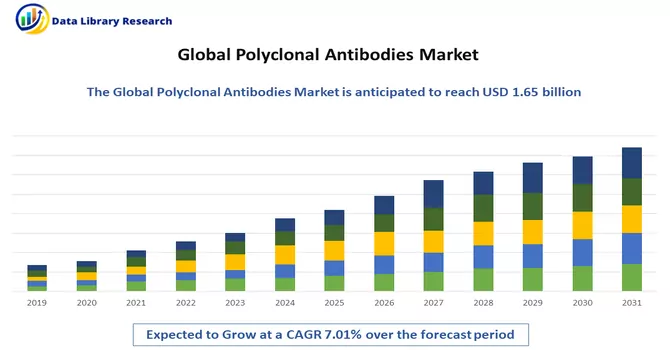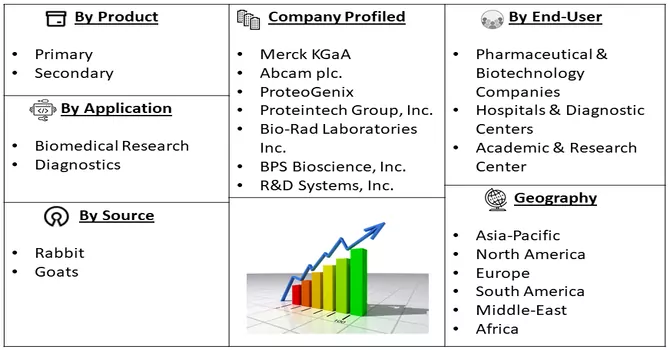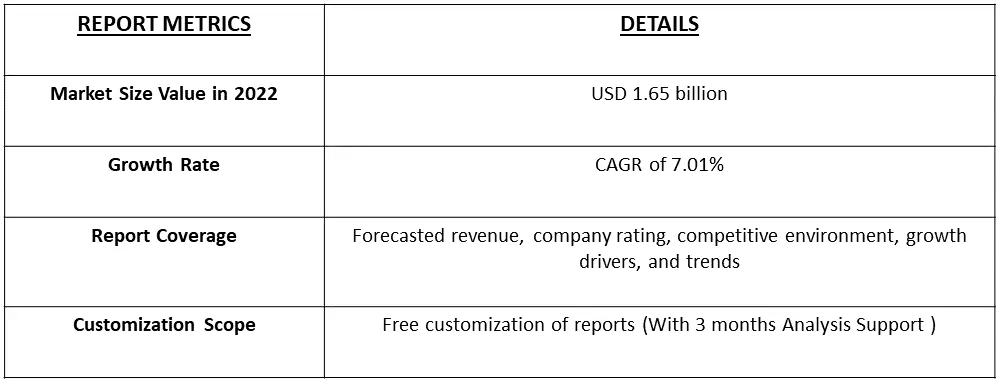The global polyclonal antibodies market size was valued at USD 1.65 billion in 2022 and is expected to grow at a compound annual growth rate (CAGR) of 7.01% from 2023 to 2030.

Get Complete Analysis Of The Report - Download Free Sample PDF
Polyclonal antibodies are a heterogeneous mixture of antibodies that are produced by different B-cell lineages within the immune system. Unlike monoclonal antibodies, which are derived from a single B-cell lineage and are therefore highly specific to a particular antigen, polyclonal antibodies are more diverse. They are generated by exposing an organism, typically a mammal such as a rabbit, goat, or mouse, to an antigen. The immune system of the organism responds by producing a range of antibodies directed against various epitopes of the antigen. Polyclonal antibodies are commonly used in research, diagnostics, and therapeutic applications. They have the advantage of recognizing multiple epitopes on a target antigen, providing a broader and more versatile binding profile. However, due to their heterogeneity, polyclonal antibodies may exhibit batch-to-batch variability, and their production involves sacrificing the immunized organism.
This trend can be primarily ascribed to the increasing incidence of infectious and chronic diseases, such as cancer, on a global scale. Additionally, advancements in antibody-based drugs, particularly in technology, and the escalating research and development activities in the biopharmaceutical industry contribute to this growth. Furthermore, when compared to monoclonal antibodies, the production cost of polyclonal antibodies is lower. Polyclonal antibodies (pAbs) find extensive applications in both qualitative and quantitative biological analyses, as well as in diverse diagnostic testing methodologies.
The increasing prevalence of infectious diseases, autoimmune disorders, and chronic conditions such as cancer is driving the demand for polyclonal antibodies. These antibodies play a crucial role in the development of diagnostic and therapeutic solutions for a broad spectrum of diseases. Moreover, the ongoing advancements in antibody-based drug development, including improved production processes and enhanced efficacy, are influencing the growth of the polyclonal antibodies market. Innovations in technology contribute to the development of more targeted and efficient polyclonal antibody therapies.
Market Segmentation: The Polyclonal Antibodies Market is Segmented By Product (Primary, Secondary), By Application (Biomedical Research, Diagnostics), By Source (Rabbit, Goats), By End-user (Pharmaceutical & Biotechnology Companies, Hospitals & Diagnostic Centers, and Academic & Research Center) and Geography (North America, Europe, Asia-Pacific, Middle East and Africa, and South America). The report offers the value (in USD million) for the above segments.

For Detailed Market Segmentation - Download Free Sample PDF
Market Drivers
Increasing Prevalence Of Chronic And Infectious Diseases
The global surge in chronic diseases, including cardiovascular conditions, diabetes, and autoimmune disorders, has created a pressing need for effective diagnostic and therapeutic solutions. Polyclonal antibodies, with their diverse binding capabilities, offer valuable tools for researchers and clinicians in understanding and addressing the complexities of chronic diseases. For instance, the American Cancer Society in January 2023, nearly 59,610 fresh leukemia cases (of all kinds) and 23,710 deaths caused due to leukemia (of all kinds) in the U.S. Polyclonal antibody treatment is widely used to treat various cancers including lymphoma, leukemia, solid tumor, and many more. Thus, such instances are expected to drive the growth of the studied market.
Increasing Biopharmaceutical R&D Activities
Continuous advancements in high-throughput screening, omics technologies, and bioinformatics tools have accelerated the drug discovery process. These technological innovations empower researchers to identify potential drug candidates more efficiently and to understand their mechanisms of action. The growing recognition of the potential impact of biopharmaceuticals has attracted increased investment and funding from both public and private sectors. Funding initiatives, grants, and collaborations contribute to the expansion of R&D capabilities. For example, in February 2023, Thermo Fisher Scientific unveiled a contract manufacturing agreement with Elektrofi, a biotechnology company based in the U.S. This agreement aims to enhance production facilities for upcoming clinical trials in biologic-based therapies. The collaboration is designed to support early clinical activities across multiple pipeline programs, facilitating rapid scaling up for late-stage and commercial advancement. Thus, the market is expected to witness significant growth over the forecast period.
Market Restraints
Stringent Regulations and Ethical Concerns Regarding Polyclonal Antibody Production
The production of polyclonal antibodies often involves immunizing animals, such as rabbits, goats, or mice. Stringent regulations are in place to ensure the humane treatment of these animals. The strict protocols for housing, feeding, and handling animals are strictly monitored are expected to slow down the growth of the studied market. In cases where polyclonal antibodies are intended for therapeutic or diagnostic use in humans, adherence to Good Manufacturing Practices (GMP) is mandatory. GMP regulations ensure the consistency, quality, and safety of biopharmaceutical products, this may be time consuming as a result, the growth of the market may slow down over the forecast period.
The urgent need for effective treatments for COVID-19 patients prompted an acceleration of research into polyclonal antibodies as potential therapeutic agents. Convalescent plasma, rich in polyclonal antibodies, emerged as a treatment option, and clinical trials were initiated to evaluate its efficacy. The disruption caused by the pandemic, including restrictions on travel, closure of laboratories, and supply chain interruptions, had implications for the production and distribution of polyclonal antibodies. Researchers and manufacturers navigated challenges to meet the heightened demand. The study of immune responses, including the production of antibodies, became a central focus in COVID-19 research. Understanding how the immune system responds to the virus, including the dynamics of polyclonal antibody production, contributed to therapeutic and vaccine development efforts. Thus, the COVID-19 impact on polyclonal antibodies reflects a dynamic and multifaceted response to the global health crisis. From therapeutic investigations to diagnostic advancements, the role of polyclonal antibodies has been pivotal in addressing the challenges posed by the pandemic.
Segmental Analysis:
Rabbits Segment is Expected to Witness Significant Growth Over the Forecast Period
Rabbits are commonly chosen as hosts for antibody production due to their robust immune response. The process typically involves immunizing a rabbit with the target antigen. The antigen can be a protein, peptide, or other substances, and the immune system of the rabbit recognizes it as foreign. Rabbits possess a unique immune system that allows for the generation of a diverse range of antibodies. When exposed to an antigen, rabbits produce polyclonal antibodies, which are a mixture of antibodies targeting different epitopes on the antigen. Moreover an article published by NCBI in April 2023, reported that polyclonal antibodies generated in rabbits are employed in various diagnostic assays. Their ability to recognize multiple epitopes makes them suitable for detecting complex mixtures of antigens, contributing to the development of sensitive and specific diagnostic tests. Thus, the segment is expected to witness significant growth over the forecast period.
Pharmaceutical & Biotechnology Companies Segment is Expected to Witness Significant Growth Over the Forecast Period
In pharmaceutical and biotechnology research, the discovery and development of novel drugs are fundamental. Polyclonal antibodies are integral tools in identifying and validating potential drug targets, as well as assessing the efficacy and safety of drug candidates. Polyclonal antibodies have therapeutic applications in treating various diseases, including autoimmune disorders and certain infections. Their diverse nature allows them to target multiple pathways, providing a broader therapeutic spectrum compared to monoclonal antibodies. Thus, due to the such advantages, the segment is expected to witness significant growth over the forecast period.
North America Segment is Expected to Witness Significant Growth Over the Forecast Period
North America asserted its dominance in the industry, capturing a substantial market share, due to the commanding position can be attributed to several factors, including the significant presence of numerous biotechnology and pharmaceutical companies, cutting-edge technology and infrastructure, a robust commitment to innovation, a stringent regulatory environment, and a well-established healthcare system.
Illustrating this trend, in July 2022, GigaGen, headquartered in California, U.S., unveiled a groundbreaking study highlighting the First-Ever Clinical GMP Manufacturing and IND-Enabling Studies for the organization’s innovative class of recombinant polyclonal antibodies (pAbs) drugs. This novel approach aims to address infectious and chronic diseases by targeting a myriad of viral epitopes. Thus, the region is expected to witness significant growth over the forecast period.

Get Complete Analysis Of The Report - Download Free Sample PDF
Companies within the polyclonal antibodies market are actively engaged in the production of innovative medical products, technological advancements, and developments. Moreover, major players are implementing strategies such as mergers and acquisitions (M&As) and collaborations to drive novel product development. Noteworthy players in the global polyclonal antibodies market include
Recent Developments:
1) In February 2023: Roche launched the IDH1 R132H (MRQ-67) Rabbit Monoclonal Primary Antibody and the ATRX Rabbit Polyclonal Antibody to identify mutation status in patients diagnosed with brain cancer
2) In December 2021, Atlas Antibodies reported the release of 1,200 new Triple-A Polyclonals, highly validated antibodies for cell and tissue analysis. These new solutions cover research areas such as cancer, cell biology, immunology, metabolism, neuroscience, transcriptional regulation, and stem cells & and developmental biology.
Q1. What was the Polyclonal Antibodies Market size in 2022?
The global polyclonal antibodies market size was valued at USD 1.65 billion in 2022.
Q2. At what CAGR is the Polyclonal Antibodies market projected to grow within the forecast perio?
Polyclonal Antibodies Market is expected to grow at a compound annual growth rate (CAGR) of 7.01% over the forecast period.
Q3. What segments are covered in the Polyclonal Antibodies Market Report?
By Procuct, By Application, By Source, By End-user and Geography these segments are covered in the Polyclonal Antibodies Market Report.
Q4. Which region has the largest share of the Polyclonal Antibodies Market? What are the largest region's market size and growth rate?
North America has the largest share of the market . For detailed insights on the largest region's market size and growth rate request a sample here
Data Library Research are conducted by industry experts who offer insight on industry structure, market segmentations technology assessment and competitive landscape (CL), and penetration, as well as on emerging trends. Their analysis is based on primary interviews (~ 80%) and secondary research (~ 20%) as well as years of professional expertise in their respective industries. Adding to this, by analysing historical trends and current market positions, our analysts predict where the market will be headed for the next five years. Furthermore, the varying trends of segment & categories geographically presented are also studied and the estimated based on the primary & secondary research.
In this particular report from the supply side Data Library Research has conducted primary surveys (interviews) with the key level executives (VP, CEO’s, Marketing Director, Business Development Manager and SOFT) of the companies that active & prominent as well as the midsized organization
FIGURE 1: DLR RESEARH PROCESS

Extensive primary research was conducted to gain a deeper insight of the market and industry performance. The analysis is based on both primary and secondary research as well as years of professional expertise in the respective industries.
In addition to analysing current and historical trends, our analysts predict where the market is headed over the next five years.
It varies by segment for these categories geographically presented in the list of market tables. Speaking about this particular report we have conducted primary surveys (interviews) with the key level executives (VP, CEO’s, Marketing Director, Business Development Manager and many more) of the major players active in the market.
Secondary ResearchSecondary research was mainly used to collect and identify information useful for the extensive, technical, market-oriented, and Friend’s study of the Global Extra Neutral Alcohol. It was also used to obtain key information about major players, market classification and segmentation according to the industry trends, geographical markets, and developments related to the market and technology perspectives. For this study, analysts have gathered information from various credible sources, such as annual reports, sec filings, journals, white papers, SOFT presentations, and company web sites.
Market Size EstimationBoth, top-down and bottom-up approaches were used to estimate and validate the size of the Global market and to estimate the size of various other dependent submarkets in the overall Extra Neutral Alcohol. The key players in the market were identified through secondary research and their market contributions in the respective geographies were determined through primary and secondary research.
Forecast Model
